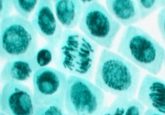Discovery of specific targeting ligands as the biomarkers for colorectal cancer

Abstract
Aim: Targeted diagnosis and therapy for colorectal cancer (CRC) is limited by the lack of specific biomarkers. Our aim was to discover CRC-specific targeting ligands using a one-bead one-compound (OBOC) combinatorial library.
Method: Samples of OBOC peptide libraries were color coded, mixed and incubated with commercially available human CRC cells (HT-29 and DLD-1). Libraries with compound beads that bound to CRC cells were selected for further screening. Compound beads that bound to both CRC cells were screened with human colonic epithelial cells to select beads that bound only to CRC cells but not to human colonic epithelial cells. Chemical structures of the positive peptides were determined by Edman chemistry. CRC-targeted imaging agents were developed by conjugation of CRC binding peptide with biotin through a hydrophilic linker and then complexed with streptavidin–Cy5.5. Immunohistochemistry studies were used to evaluate CRC detection efficacy. Targeting specificity was further tested with subcutaneous CRC xenografts in nude mice.
Results: Two cyclic peptides, CRC-6 and CRC-9, composed of natural and unnatural amino acids, bind specifically to CRC cells with moderately high affinity and specificity. CRC-9 is able to detect CRC cells grown on chamber slides at the concentration of 1 µM after 30 min incubation. Tail vein injection of 1.8 nmol biotinylated peptide CRC-9, complexed with streptavidin–Cy5.5 (SA–Cy5.5), is able to target the subcutaneous CRC xenograft implants in nude mice. None of the two peptides showed cytotoxic effect on human blood cells, up to the concentration of 500 µM.
Conclusion: CRC-9 has the potential to be developed as an effective biomarker for improving the management of CRC patients by enhancing the efficiency of detection and efficacy of targeting treatment.




